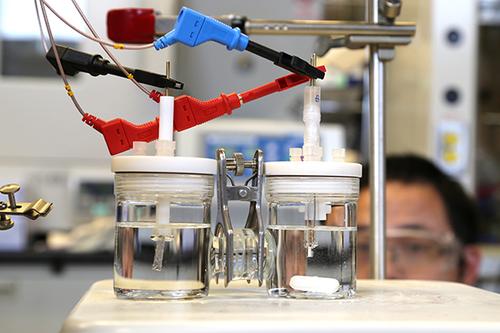Photosynthesis Inspires New Method for Renewable Energy Storage
Researchers in Canada have made a breakthrough in the chemical process of storing energy, paving the way for more viable options for storing alternative energy sources on a larger scale.
April 20, 2016
Researchers in Canada have made a breakthrough in the chemical process of storing energy by mimicking the natural process of photosynthesis, paving the way for more viable options for storing alternative energy sources on a larger scale.
A team at the University of Toronto’s Faculty of Applied Science and Engineering has developed a device that splits water into hydrogen and oxygen -- what plants also do during photosynthesis -- creating what they say is to-date the most efficient catalyst for storing energy in a chemical form.
“The research identifies a new path to split water using electricity from renewable sources, such as solar and wind,” Edward Sargent, a professor in the Department of Electrical and Computer Engineering, told Design News in an interview. “The improvement in this new catalyst is that it significantly reduces the energy required to split water at a high rate -- a high intensity of fuel electrosynthesis.”
Solar and wind energy today is typically stored in batteries, which are expensive and can only store a fixed amount of energy. There is a significant amount of research aimed at creating better and more efficient batteries and providing other means of storage to allow the traditional electric grid to fully take advantage of renewables.

An electrolyzing device developed by researchers at the University of Toronto splits water into its component elements, oxygen and hydrogen, allowing efficient storage of alternative energy in chemical form.
(Source: Marit Mitchell, University of Toronto)
The work by the Toronto team contributes to this effort by enabling the development of more energy-efficient means of storing energy from renewable resources, Sargent said.
“A kilowatt hour of electrical power could be stored with less total loss -- i.e. it could come closer to being a stored kilowatt hour,” he explained. “This would in turn improve the cost-effectiveness of storage, since people are generally willing to pay at a certain rate for a retrieved kilowatt hour, so the energy storage round-trip efficient contributes directly to cost-effectiveness.”
The research relates to a previous effort by the team to make improved oxygen-evolving catalysts, known as OER catalysts, Sargent said. “This work represents a step forward in the performance of the OER catalyst relative to previous reports,” he said.
Advancements of the current work over the previous work include collaborating with a leading group in computational materials science at Stanford University. Using their computer predictions enabled the team to focus on a particularly promising new material -- tungsten -- to include in its catalyst, Sargent said. Using natural materials like this also contribute to the cost-effectiveness of the method for energy storage, he added.
READ MORE ARTICLES ON SOLAR ENERGY:
The team also found a new chemical strategy to make sure the multiple metals used -- which include not only tungsten but also iron and cobalt -- were thoroughly mixed with one another. “This intimate elemental mixing was essential to the success of the approach,” Sargent said.
The team is continuing its research by working to translate its ideas to systems that are not just for storage of hydrogen, but also for carbon dioxide. This can help make it applicable for real-world, commercial energy-storage scenarios.
“In particular, we are working to take carbon dioxide from the atmosphere, and convert it into carbon-based fuels,” Sargent said. “These will be akin to what we use today -- methane, ethanol, etc. -- but instead of being fossil fuels, will be synthesized from renewable electricity and carbon dioxide.”
Elizabeth Montalbano is a freelance writer who has written about technology and culture for more than 15 years. She has lived and worked as a professional journalist in Phoenix, San Francisco, and New York City. In her free time she enjoys surfing, traveling, music, yoga, and cooking. She currently resides in a village on the southwest coast of Portugal.
About the Author(s)
You May Also Like

.jpg?width=300&auto=webp&quality=80&disable=upscale)

